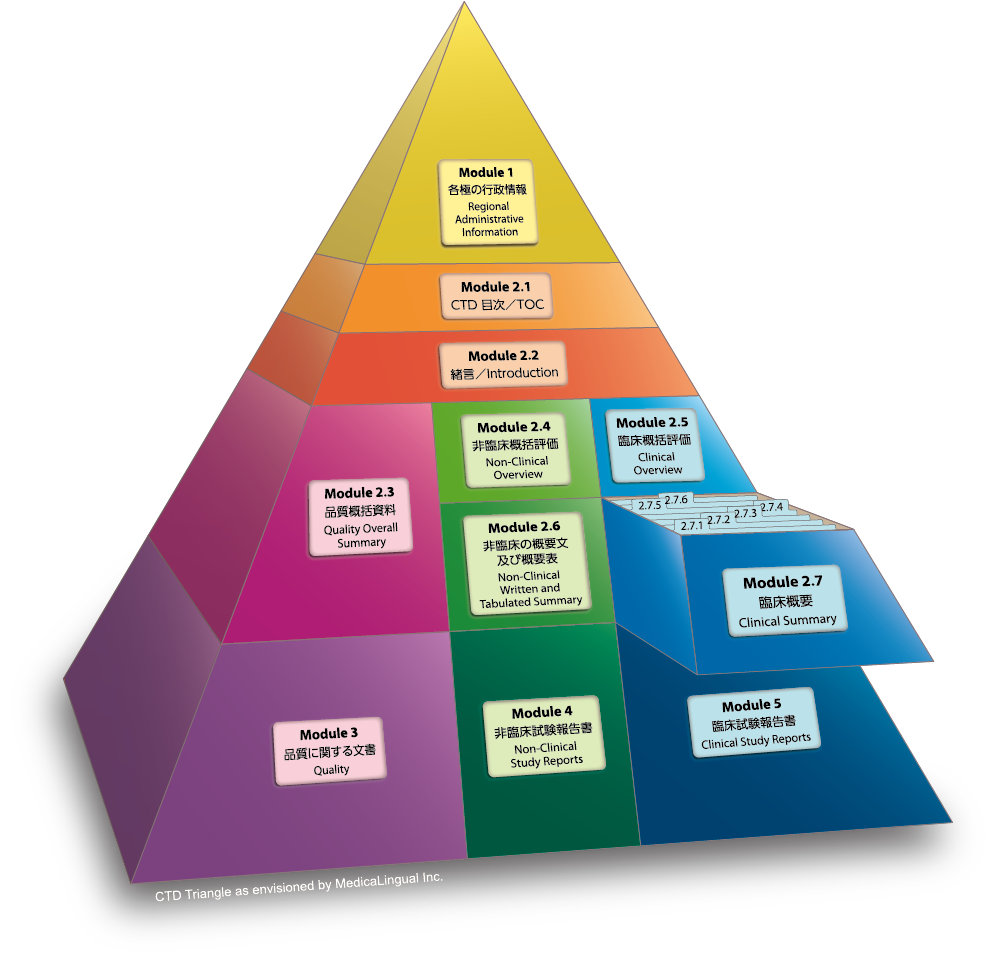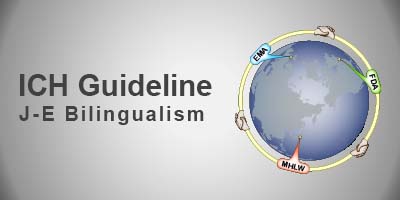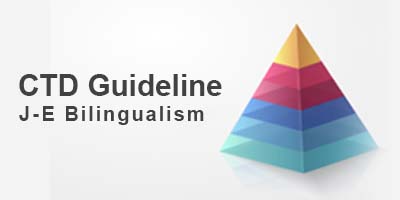
薬生薬審発0202第1号(平成29年2月2日)
ICH HARMONISED GUIDELINE- M4E(R2) – Dated 15 June 2016
Module 2.7 臨床概要
2.7.4 臨床的安全性の概要
2.7.4.5 特別な患者集団及び状況下における安全性
2.7.4.5.1 内因性要因
本項では、ICH E5にて「内因性民族的要因」と定義される人口統計学的因子や他の要因に基づいて治療及び管理を患者個々に考慮するための安全性データを要約すること。内因性要因には、年齢、性別、身長、体重、除脂肪体重、遺伝子多型、身体組成、他の疾患及び臓器機能不全が含まれる。申請適応症が小児でも考えられる場合は、小児における安全性も分析すること。これらの要因が安全性に与える影響については他項に記載されることになるが、腎疾患又は肝疾患患者等における安全性は、薬物動態、その他の情報と共に本項で要約すること。もし、高血圧、心疾患、糖尿病等の特定の合併症のある患者の例数が十分であれば、合併症が治験薬の安全性にどのような影響を与えるのか分析すること。患者部分集団における解析を行う場合は、作成した有害事象の表又は記述を相互に参照すること。
Module 2.7 CLINICAL SUMMARY
2.7.4 Summary of Clinical Safety
2.7.4.5 Safety in Special Groups and Situations
2.7.4.5.1 Intrinsic Factors
This section should summarise safety data pertinent to individualising therapy or patient management on the basis of demographic and other factors defined as “intrinsic ethnic factors” in ICH E5. These factors include age, sex, height, weight, lean body mass, genetic polymorphism, body composition, other illness and organ dysfunction. Safety in the paediatric population should be routinely analysed in applications for a proposed indication that occurs in children. Analysis of the impact of such factors on safety outcomes should have been presented in other sections but should be summarised here, together with pertinent PK or other information, e.g., in patients with renal or hepatic disease. If a sufficiently large number of subjects with a given co-morbid condition such as hypertension, heart disease, or diabetes, was enrolled, analyses should be carried out to assess whether the co-morbid condition affected the safety of the drug under study. Cross reference should be made to the tables or description of adverse events when analyses of such sub-groups has been carried out.
2.7.4.5.2 外因性要因
本項では、ICH E5にて「外因性民族的要因」と定義される人口統計学的因子や他の要因に基づいて治療及び管理を患者個々に考慮するための安全性データを要約すること。これらの因子は、患者をとりまく環境に関する因子である。例としては、医療環境、他剤の使用状況(第2.7.4.5.3項、薬物相互作用を参照)、喫煙、飲酒、食事の習慣等が挙げられる。
例えば、代謝プロフィール、試験結果、市販後調査又は類薬情報等により飲酒と治験薬との相互作用が示唆される場合、それらの内容を本項に示すこと。
2.7.4.5.2 Extrinsic Factors
This section should summarise safety data pertinent to individualising therapy or patient management on the basis of factors defined as “extrinsic ethnic factors” in ICH E5. These are factors associated with the patient environment. Examples are the medical environment, use of other drugs (see 2.7.4.5.3, Drug Interactions), use of tobacco, use of alcohol, and food habits.
For example, if a potential interaction with alcohol is suggested by the metabolic profile, by the results of studies, by post-marketing experience, or by information on similar drugs, information should be provided here.
2.7.4.5.3 薬物相互作用
薬物-薬物又は薬物-食事相互作用に関する試験は、CTD臨床薬理試験の要約の項(第2.7.2項)に要約すること。これらの相互作用が安全性に与える影響については、薬物動態、薬力学や臨床的観察に基づいて分析し本項で要約すること。さらに、他の治療との併用時に観察された有害事象プロフィールの変化、リスクに結びつきそうな血中濃度の変化、被験薬の薬効の変化等を本項で示すこと。
2.7.4.5.3 Drug Interactions
Studies on potential drug-drug or drug-food interactions should be summarised in the Summary of Clinical Pharmacology Studies section of the CTD (Section 2.7.2). The potential impact on safety of such interactions should be summarised here, based on PK, PD, or clinical observations. Any observed changes in the adverse event profile, changes in blood levels thought to be associated with risk, or changes in drug effects associated with other therapy should be presented here.
2.7.4.5.4 妊娠及び授乳時の使用
開発中及び他の情報源から得られた妊娠及び授乳時の安全性に関する情報を本項で要約すること。
2.7.4.5.4 Use in Pregnancy and Lactation
Any information on safety of use during pregnancy or breast-feeding that becomes available during clinical development or from other sources should be summarised here.
2.7.4.5.5 過量投与
過量投与に関連すると思われる臨床症状、臨床検査値所見、対症療法、解毒薬の使用等のデータがあれば、全ての情報を要約し考察すること。また、過量投与に対する解毒薬や透析の有効性も、データがあれば記載すること。
2.7.4.5.5 Overdose
All available clinical information relevant to overdose, including signs/symptoms, laboratory findings, and therapeutic measures/treatments and antidotes (if available) should be summarised and discussed. Information on the efficacy of specific antidotes and dialysis should be provided if available.
2.7.4.5.6 薬物乱用
ヒト及び動物における新薬の依存性に関する試験や情報を要約し、「非臨床概要」を参照すること。特に依存性を生じやすい患者集団を明らかにすること。
2.7.4.5.6 Drug Abuse
Any relevant studies/information regarding the investigation of the dependence potential of a new therapeutic agent in animals and in humans should be summarised and cross-referenced to the nonclinical summary. Particularly susceptible patient populations should be identified.
2.7.4.5.7 離脱症状及び反跳現象
当該被験薬の反跳作用に関する試験結果及び情報を要約すること。二重盲検試験や実薬投与の中止後に何らかの事象が発現したり、重症度を増したりした場合、それが投与中止によるものかどうか検討すること。離脱症状、反跳現象を評価するよう計画された試験には特に重視すること。
耐薬性に関するデータを「臨床的有効性の概要」の第2.7.3.5項に要約すること。
2.7.4.5.7 Withdrawal and Rebound
Any information or study results pertinent to rebound effects should be summarised. Events that occur, or increase in severity, after discontinuation of double-blind or active study medication should be examined to see if they are the result of withdrawal of the study medication. Particular emphasis should be given to studies designed to evaluate withdrawal and/or rebound.
Data concerning tolerance should be summarised under section 2.7.3.5 in the Summary of Clinical Efficacy.
2.7.4.5.8 自動車運転及び機械操作に対する影響又は精神機能の障害
五感、協調運動、その他の障害に基づく自動車運転や機械操作能の低下、精神機能の障害等に関する安全性データを要約すること。これには安全性モニタリングで報告された関連する有害事象(例:眠気)及び自動車の運転や機械操作能力に及ぼす影響、精神機能障害に関する特別な試験が含まれる。
2.7.4.5.8 Effects on Ability to Drive or Operate Machinery or Impairment of Mental Ability
Safety data related to any impairment in the senses, co-ordination, or other factor that would result in diminished ability to drive a vehicle or operate machinery or that would impair mental ability should be summarised. This includes relevant adverse effects reported in safety monitoring (e.g., drowsiness) and specific studies concerning effects on ability to drive or operate machinery or impairment of mental ability.










